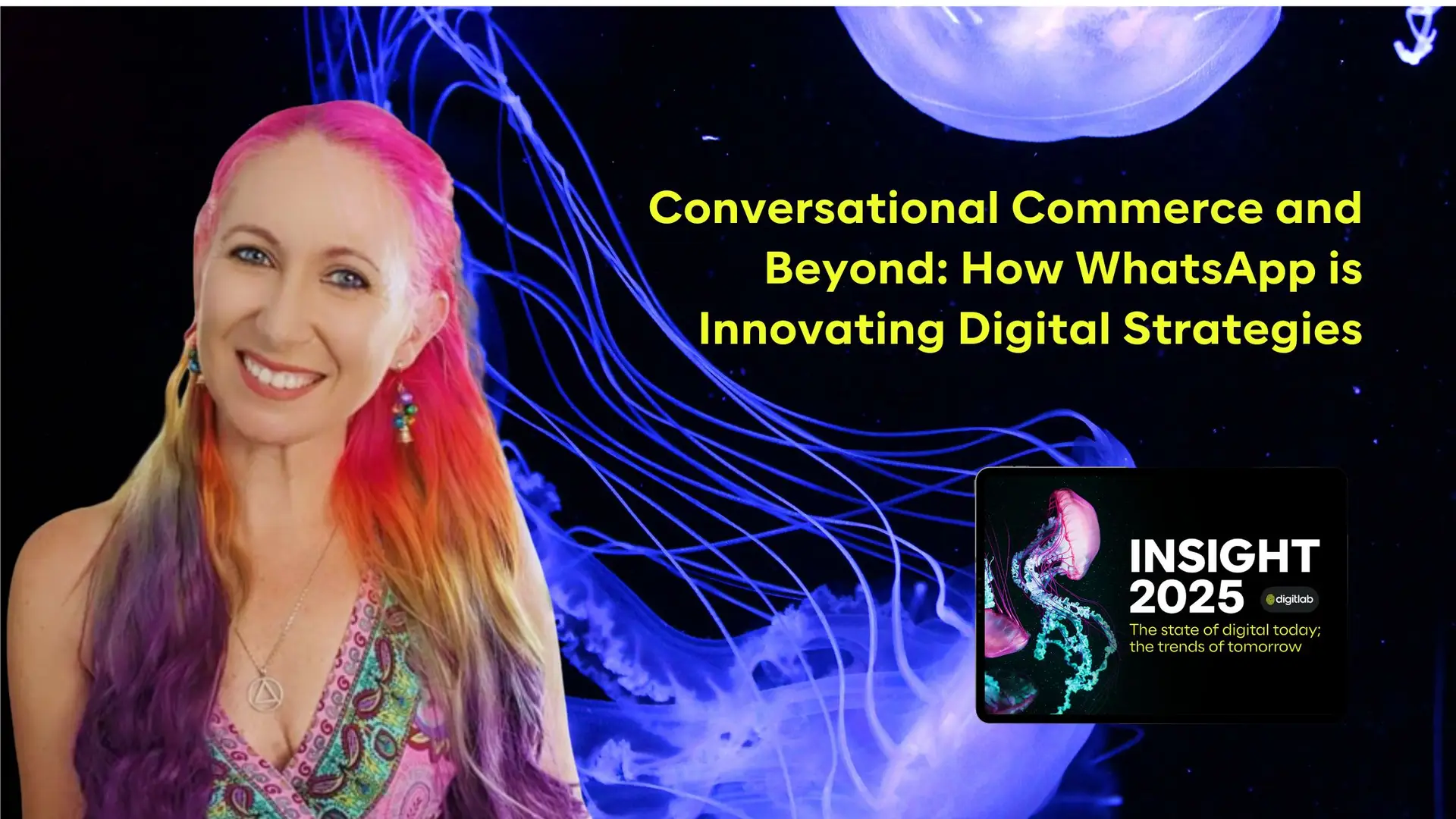In Insight 2025: State of Digital, Michelle Matthee, Head of Customer Success at Chat Inc., delves into the innovative role of WhatsApp in her article Conversational Commerce and Beyond: How WhatsApp is Innovating Digital Strategies. She explores how this platform, once a simple messaging tool, has become a cornerstone for modern business communication, blending marketing, customer service, and commerce into seamless, engaging interactions.
Businesses are constantly evolving to meet the demands of a more connected, conversational world. WhatsApp, once primarily a personal messaging app, is now an essential tool in that transformation, enabling companies to communicate directly with customers in ways that drive meaningful engagement and results. From retail to finance and beyond, WhatsApp has proven its ability to seamlessly blend marketing, customer service, and commerce into a single, fluid conversation.
This shift toward real-time, personalized interactions is what sets WhatsApp apart as a channel that doesn’t just reach customers—it engages them. By facilitating smooth, conversational commerce, WhatsApp allows businesses to build stronger relationships and deliver experiences that lead to conversions.
Real-World Success: How Retail Brands Are Leading with WhatsApp
The retail sector has seen particularly strong returns from using WhatsApp to connect with customers. One retail client ran a three-month campaign, sending personalised promotions and product recommendations. The result? A 90% read rate, a 25% customer response rate, and a 14% sales increase. These kinds of numbers underscore the power of a direct, real-time connection that cuts through the noise and delivers relevant, engaging content to customers who are ready to act.
Another retailer used WhatsApp to send 130,000 messages over an eight-week promotional campaign, yielding a 75% read rate, 15% conversion rate, and a 335% return on investment. By leveraging WhatsApp’s ability to engage customers in one-on-one conversations, they turned customer interest into action, converting interactions into sales at an impressive rate.
These examples show WhatsApp’s value not just as a messaging platform, but as a driver of results for businesses that need to reach customers in a more personal, impactful way.
Why WhatsApp for Marketing is a Game-Changer
WhatsApp’s role in marketing goes beyond simple communication. It allows businesses to deliver personalised campaigns that resonate with their target audiences. Customers are much more likely to engage with a message received through WhatsApp than through traditional channels like email. This is partly due to WhatsApp’s open rates, which consistently exceed 90%, but it’s also because the conversations feel more immediate and personal.
WhatsApp’s interactive capabilities—such as rich media, quick-reply buttons, and links—mean that customers can engage with a brand in a way that’s both convenient and immersive. Whether it’s a product video, a discount offer, or an interactive survey, WhatsApp makes it easy for customers to take action right from the message.
Using the WhatsApp Business API to send campaigns at scale further enhances the platform’s power, allowing businesses to send messages to multiple recipients without creating group chats. Each customer receives the message individually, which maintains the one-on-one feeling that is key to building trust and driving engagement.
Businesses can also re-engage customers outside of WhatsApp’s 24-hour window by using message templates. The time taken to approve these templates has dramatically improved in the last year from up to 24 hours, to approval in under 5 minutes. These pre-approved messages are perfect for reminders about abandoned carts, limited-time offers, or personalised recommendations based on a customer’s shopping habits.
This combination of personalised, targeted messaging and instant engagement capabilities makes WhatsApp an indispensable tool for marketing campaigns that want to cut through the noise and create meaningful interactions.
Conversational Commerce: Making Buying a Seamless Experience
WhatsApp truly excels in its ability to facilitate conversational commerce—a seamless blending of chat-based interactions with the purchasing process. Instead of guiding customers through multiple platforms or websites, businesses can keep everything within WhatsApp, providing a frictionless experience that moves from inquiry to purchase with minimal effort on the customer’s part.
Take WhatsApp’s Flows feature, for example. It allows businesses to create app-like journeys within the chat. Customers can browse products, fill out forms, or complete a purchase without ever leaving the conversation. This kind of integrated journey is invaluable for reducing the barriers that typically cause customers to abandon their shopping carts or lose interest.
The Product Catalog feature goes a step further by turning WhatsApp into a digital storefront. Customers can browse product images, check descriptions, and make informed buying decisions directly in the chat. This is ideal not only for retail but also for sectors like hospitality and travel, where customers can explore offerings, such as hotel rooms or vacation packages, before booking—all in a single conversation.
This level of integration—combining product discovery, personalised service, and payment options—makes WhatsApp a key player in the growing trend of conversational commerce, where businesses don’t just sell, they converse and guide customers through every step.
WhatsApp as a Cost-Efficient Customer Service Solution
In 2024, WhatsApp is not just a marketing tool—it’s also reshaping customer service. A recent update to Meta’s fee structure means that service messages from customers, and the back-and-forth conversations that follow, are now free for the first 24 hours. For businesses handling high volumes of customer inquiries, this translates to huge cost savings, especially when using chatbots or helpdesk integrations.
Imagine a scenario where a customer reaches out to inquire about an order’s status. Using a WhatsApp chatbot, the business can provide the relevant information quickly and without additional costs, as long as the interaction happens within the 24-hour window. If the issue becomes more complex, the conversation can be escalated to a live agent—all while still benefiting from the free window.
This change has opened up new opportunities for industries such as healthcare, retail, and financial services, where timely responses are crucial to maintaining customer satisfaction. The cost efficiency and responsiveness WhatsApp offers make it an essential part of modern customer service strategies.
Additionally, WhatsApp has reduced the price of utility messages to match the cost of SMS, but with more advanced features, like the ability to include rich media and interactive buttons. This makes WhatsApp a superior choice for sending appointment reminders, payment updates, or delivery notifications, offering businesses a more engaging way to communicate critical information while keeping costs low.
Driving Engagement Through Interactive Features
WhatsApp’s interactive features have fundamentally changed how businesses communicate with their customers, turning static exchanges into dynamic conversations that invite engagement. These features don’t just deliver information—they create experiences. By incorporating interactive elements like carousel messages, quick-reply buttons, and interactive templates, businesses can craft more fluid and responsive interactions that feel intuitive for the user.
Carousel messages are a particularly powerful tool in this shift. They allow businesses to present multiple products or service options within a single message, offering customers a visually engaging way to browse and compare without needing to leave the conversation. This is invaluable for industries that deal with a range of choices, such as retail, where a single carousel can display various product colours, styles, or related items. For service-based industries, it’s an ideal way to showcase options like appointment slots, package tiers, or different service offerings, all without overwhelming the user with separate messages.
But the real beauty of interactive features is in how they simplify decision-making. Customers can explore options in a clear, concise manner, and make choices right within the message itself. The frictionless nature of this process—the ability to browse, compare, and act all in one flow—keeps engagement levels high and reduces the drop-off rates typically seen when customers are asked to switch between platforms.
Quick-reply buttons take this a step further by making customer interaction nearly effortless. Instead of requiring a user to type out a response, they can simply tap a button to select an option, confirm a purchase, or ask for more information. This not only makes the interaction faster but also more appealing to customers who value convenience. It’s ideal for high-volume customer interactions, such as booking appointments or confirming orders, where speed and ease of use are crucial.
Interactive templates also allow businesses to engage users in a structured yet flexible way. These templates are especially valuable in scenarios that require follow-ups or time-sensitive responses. For example, after a customer adds an item to their cart but doesn’t complete the purchase, a reminder template with an embedded quick-reply button can be sent. The customer can simply tap to finalize the purchase or even browse additional items. Similarly, for event registrations or promotions, templates make it easy to track user responses and prompt immediate action, boosting participation rates without putting extra pressure on the customer.
What makes these interactive features particularly engaging is that they don’t just enable quick transactions—they keep the conversation going. Customers feel like they’re being guided through a process, rather than left to navigate on their own. Whether it’s following up on an inquiry, sending personalized recommendations, or prompting users to explore new products, these interactions keep the momentum of the customer journey intact. Every tap brings the customer closer to their goal, without the disruptive steps often seen in traditional messaging or email-based interactions.
As businesses explore more ways to integrate these features, we’re likely to see even deeper personalisation and real-time engagement. For example, by integrating these interactive tools with data from CRM systems, businesses can send highly customised messages—showing customers items they’ve previously browsed or suggesting complementary products based on past purchases. This level of personalisation, delivered in a dynamic and interactive format, ensures that customers not only stay engaged but also feel understood and valued.
In the end, WhatsApp’s interactive features aren’t just about driving engagement—they’re about creating a frictionless experience where the customer’s path from curiosity to action feels natural, effortless, and engaging. It’s this ease of interaction, coupled with the immediacy of the platform, that makes WhatsApp an indispensable tool for businesses looking to stay connected with their audiences and drive meaningful results.
WhatsApp: The Ultimate Engagement Tool Across Industries
While retail is leading the way in leveraging WhatsApp’s capabilities, the platform is proving invaluable across a range of industries. Healthcare providers are using WhatsApp to send appointment reminders, follow-up messages, and even test results in a secure and compliant way. Financial services firms are streamlining processes like loan applications and account updates by using WhatsApp to keep clients informed and engaged in real time. Travel companies, too, are benefiting from WhatsApp’s ability to provide personalised travel itineraries, promotions, and booking confirmations, all within the app.
What ties these industries together is WhatsApp’s ability to deliver real-time, personalised interactions that drive engagement and build stronger customer relationships. Whether helping customers find the right product, resolving issues efficiently, or providing important updates, WhatsApp is a powerful tool for businesses looking to enhance their digital strategies and improve customer satisfaction.
Looking Ahead: WhatsApp’s Growing Role in 2025 and Beyond
As WhatsApp continues to evolve, its trajectory points to even greater integration within business strategies. What’s clear is that WhatsApp has already positioned itself as a platform that goes beyond communication—it’s becoming a core operational tool. Looking ahead, it’s not just about what the platform offers today but the new avenues it will open up as businesses adapt to a more digitally-driven future.
One area where we expect to see substantial growth is in automation and AI-driven customer interactions. As businesses increasingly rely on data to understand customer needs, WhatsApp will likely evolve to support more advanced AI tools that deliver hyper-personalised responses in real-time. Imagine conversations where AI not only answers questions but anticipates needs based on previous behaviour, enhancing the customer experience without human intervention. This next step in AI integration could redefine what’s possible in customer service, creating faster, smarter, and more contextually relevant interactions.
The platform’s seamless integration with other business systems will also become more robust. The future will likely see deeper connections between WhatsApp and CRM platforms, inventory management systems, and analytics tools, allowing businesses to gain a fuller picture of customer journeys from a single interface. This kind of connected ecosystem would offer businesses the ability to optimise customer experiences even further, from marketing to fulfilment, ensuring every interaction feels smooth and cohesive.
We can also expect to see in-app payments expand in more regions, streamlining the customer journey from product discovery to checkout. This will give businesses the ability to close sales within WhatsApp itself, enhancing convenience for customers and making transactions frictionless. In industries like retail, hospitality, and services, this evolution will be pivotal for improving conversion rates and encouraging repeat business. Payments are not yet available in WhatsApp for South Africa, but as it moves through the BETA testing in other regions, we should see this released into the global market.
Lastly, as more businesses recognise WhatsApp’s potential, we’ll likely see it integrated into omnichannel strategies, where customer interactions flow effortlessly across various touchpoints—from websites to in-store experiences to WhatsApp. Businesses that successfully adapt to this omnichannel world will be those that use WhatsApp not as an isolated channel but as part of a broader, unified customer engagement strategy.
The future of WhatsApp is one of deeper integration, smarter automation, and seamless customer experiences. As we look to 2025 and beyond, it’s clear that businesses that embrace these trends will be those that thrive, finding new ways to engage customers, streamline operations, and remain agile in an increasingly digital world. WhatsApp will be at the centre of this shift, offering businesses more than just a messaging platform, but a key to unlocking future success.
You can read more from our other contributors and download the full report here: https://digitlab.co.za/digital-trends-report/






